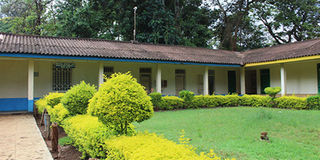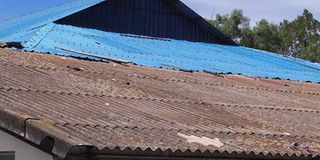Asbestos, the deadly material lining Kenya's public institutions

Asbestos roofing on buildings housing the Meru County Directorate of Environment. The county government has been accused of failing to sensitise the public on the health risk posed by asbestos. PHOTO | GITONGA MARETE | NATION MEDIA GROUP
Seven months after Cabinet Secretary for Environment, Aden Duale, set a firm deadline of December for property owners still using asbestos roofing to bear the cost of removing and safely disposing of it, in line with recommendations from NEMA, the Cabinet has now officially approved a nationwide initiative to eliminate the hazardous material from public and private facilities.
Despite the directive issued in August last year, many public institutions, including hospitals, and private property owners have continued to defy the order, leaving buildings with asbestos still in place.
The World Health Organization classifies asbestos as a group of naturally occurring mineral fibres that you might find in old roofs, floors, pipes, and insulation. While it was considered strong, heat resistant and affordable, asbestos is harmful to health. When it's disturbed, like during construction or renovation, it can release tiny fibres into the air.
The WHO attributes more than 200,000 deaths globally every year to asbestos, along with a heavy impact on people's health.
"All six main forms of asbestos have been assessed by WHO as being carcinogenic to humans," states the agency responsible for international public health.
"Asbestos exposure, including chrysotile, causes cancer of the lung, larynx and ovaries, and mesothelioma, a type of cancer that affects the thin layers of tissue that cover most of the organs in the body. There is also clear scientific evidence that asbestos causes chronic respiratory diseases such as asbestosis (fibrosis of the lungs), and other adverse effects on the lungs."
Because of its use in building materials, WHO says that anyone engaging in construction, maintenance and demolition of buildings where asbestos has been used is potentially at risk, even many years or decades after the asbestos was put in place.
Kenya's construction industry extensively used asbestos in the 1960s as the minerals were considered to be strong, heat resistant and affordable.
Its peak global consumption occurred between the 1970s and 1980s before health risks became widely acknowledged.
More than 60 countries all over the world have implemented complete or partial bans, including the entire European Union, Australia, Japan, and Canada. In 2006, Kenya joined countries that were getting rid of the hazardous material.
"We cannot compromise on the health of our citizens. It is raining everywhere, and people are consuming water contaminated by these roofs. I apologise on behalf of previous regimes, but this government must tackle this issue for the sake of public health," Duale said in December last year when he appeared at the Petitions Committee of the National Assembly.
Documents seen by Nation reveal that various government institutions didn't heed the directive, with public institutions being the top five leading facilities with asbestos. The National Treasury & Economic Planning has 80,468 tonnes, with the Ministry of Lands, Urban Planning, Housing & Public Works coming second with 4,941 tonnes.
Other ministries with a high number of asbestos include the Ministry of Interior & National Coordination, the Ministry of Education and the Ministry of Health with 2,143 tonnes. The Private sector has a total of 8,467 tonnes of asbestos.
Based on mapping done by NEMA, many county referral hospitals, Sub-County hospitals, and health centres across the country contain significant amounts of asbestos, primarily in roofing materials, wall panels, and staff quarters.
For instance, Kisii Teaching and Referral Hospital has a high asbestos content of 100 tonnes, Kabarnet County Referral Hospital and Kitui County Referral Hospital each with 50 tonnes each.
According to government documents, 188 schools and other learning institutions have been found to contain asbestos in various quantities, amounting to 3,180.5 tonnes.
Mumias Sugar Company is among the top in the private sector category with 366.34 tonnes of asbestos found.
According to the cabinet directive, NEMA will oversee the safe removal, disposal, and handling of asbestos. County governments were urged to establish designated disposal sites.
Total Asbestos Tonnage
• Government Ministries: 21,604.717 tonnes
• Private Entities: 8,467.399 tonnes
• Combined Total: 30,072.116 tonnes
Top 5 ministries with the highest asbestos tonnage
1. Ministry of Lands, Urban Planning, Housing & Public Works: 4,941.29 tonnes
2. Ministry of Interior & National Coordination: 4,669.056 tonnes
3. Ministry of Education: 3,180.5 tonnes
4. Ministry of Health: 2,143.997 tonnes
5. Ministry of Agriculture & Livestock: 1,742.248 tonnes
Notable facilities with high asbestos content
• Moyale KRA Border Post: 8,000 tonnes (under National Treasury)
• Police Line Across The County: 2,640 tonnes (under Interior Ministry)
• Flamingo Estate: 1,450 tonnes (private entity)
• Marsabit County commissioners Compound Grain store: 1,000 tonnes (Interior Ministry)
• Lokitaung Government staff houses: 930 tonnes (Housing Ministry)
Top Health Facilities with Highest Asbestos Content
1. Kisii Teaching and Referral Hospital: 100 tonnes
2. Kabarnet County Referral Hospital: 50 tonnes
3. Kitui County Referral Hospital: 50 tonnes
4. Kyuso Sub-County Hospital: 50 tonnes
5. Rift Valley Provincial General Hospital: 178.06 tonnes
6. Gilgil Sub-County Hospital: 59.06 tonnes
7. Runyejes Level 4 Hospital: 80 tonnes
8. Kianjokoma Health Centre: 140 tonnes
9. Ishiara Level 4 Hospital: 37 tonnes
10. Kigumo Subcounty Hospital: 57 tonnes
11. Muthithi (PCEA) Dispensary: 92 tonnes
Karegi Catholic Dispensary: 500 tonnes (highest single health facility)

A building at Nanyuki High School with asbestos roofing which Nema wants replaced with iron sheets saying it poses health risks to students and teachers.
Sample Learning Institutions with Highest Asbestos Content in tonnes
• Utafiti Primary School 130
• Kalro Houses 169
• Egerton University 400
• Sabatia Primary school 3
• Maji Mazuri school 5
• Baringo High School 4
• Timborua Secondary School 4
• Kapropita girl’s school 6
• Kabarnet High School 7
• Kenyatta High School 3.5
Explainer: How to tell if your building has asbestos
Asbestos can be difficult to identify visually, as it is used in many building materials. Here's how to determine if your building might contain asbestos:
Consider the age of your building
• Buildings constructed between the 1940s and 1990s are most likely to contain asbestos
• Homes built before 1980 have a high probability of containing asbestos materials
• In Kenya, many government and institutional buildings constructed during this period used asbestos extensively
Common places asbestos was used
• Roofing materials (especially corrugated cement roofing sheets)
• Ceiling tiles and insulation
• Floor tiles (particularly 9"×9" vinyl tiles)
• Pipe insulation and cement pipes
• Wall panels and cement sheeting
• Textured paints and coatings (popcorn ceilings)
• Boiler and furnace insulation
• Around electrical fixtures
Warning signs
• Corrugated cement roofing that appears grey and brittle
• Deteriorating ceiling tiles or pipe insulation
• Crumbling or damaged wall panels
• Worn flooring revealing fibrous backing material
Professional Identification
• Important: You cannot reliably identify asbestos by sight alone
• The only definitive way to identify asbestos is through laboratory testing
• Hire a certified asbestos inspector for proper testing
• Never try to take samples yourself as this can release dangerous fibers
What to do if you suspect asbestos
1. Don't panic - undisturbed asbestos generally poses minimal risk
2. Don't drill, sand, cut or disturb suspected materials
3. Keep children away from damaged materials
4. Contact a licensed asbestos professional for testing
5. If confirmed, discuss removal or containment options with certified professionals
Remember that asbestos is dangerous primarily when materials are damaged and fibres become airborne. Intact asbestos-containing materials are generally not an immediate health risk.

